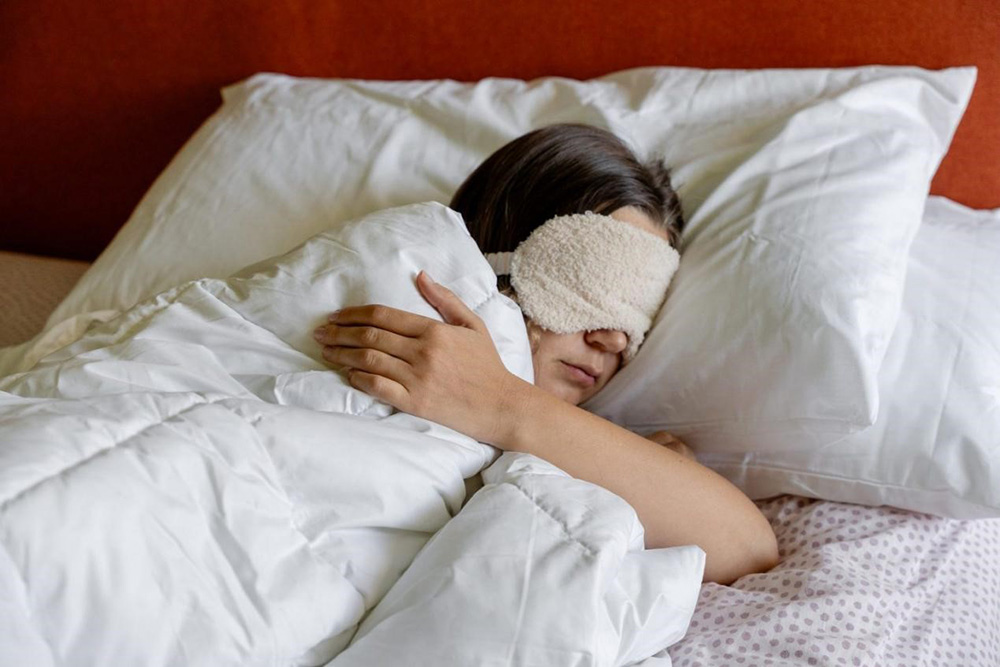
一直以来,医学界都把保证优质睡眠作为保持身心健康和延缓衰老的首要生活习惯,保证优质睡眠还能降低患心脏病等慢性疾病的风险。网上也有也很多优质睡眠小妙招,有的让你睡前用胶带封住嘴巴,有的让你睡前洗热水澡,还有的让你睡觉前把手机锁起来。越来越多的人也开始追求所谓的“极致睡眠”,他们孜孜不倦地追求各种助眠妙招,以获得更高质量的睡眠。其中一个“助眠黑科技”叫做“认知洗牌睡眠法”,它是“数绵羊”的近亲,但是操作起来更随意。
那么,什么是“认知洗牌睡眠法”,它真的像宣传的那样有效吗?专家们对此做出了解释。
什么是“认知洗牌睡眠法”?
“认知洗牌睡眠法”,是指你故意联想一些彼此没有关联的词语,通过创造一种随机性,来分散你的注意力,从而降低你的情绪反应和清醒程度的方法。TikTok上的一位医生表示,这种方法“能像洗牌一样重整你的思绪”,这种随机性也很容易触发我们入睡前经常会做的那种零散的梦,从而有助于引导入睡。
举个例子,你可以从英文字母表里随便选一个字母,比如字母B,然后每隔5到10秒钟,想出一个以该字母开头的单词,例如船(boat)、鲜花(bouquet)、面包(bread)。在你想到这个单词的同时,你的脑中就会自然而然地呈现出与之对应的画面。
睡眠呼吸暂停症治疗公司Complete Sleep的医疗总监大卫・罗森对《财富》表示:“认知洗牌睡眠法是一种心理助眠法,它的目的是干扰大脑的逻辑性和专注性的思考倾向,从而帮人入睡。”
“认知洗牌睡眠法”最早是由认知科学家吕克・博杜安提出的。在2016年的一项研究中,博杜安发现,与“睡前写下困扰你的事”相比,“认知洗牌睡眠法”的助眠效果更好,操作起来也更简单。
罗森指出:“研究表明,进行非线性的、略带随机性的思考,能够干扰人的分析性思维,而分析性思维是让人难以入睡的重要原因。这种睡眠法的核心原则也符合我们对睡眠转换相关认知过程的认识。”
我应该尝试“认知洗牌睡眠法”吗?
罗森表示,这种睡眠法对失眠的人确实有效,特别是对那些容易在夜间大脑过度活跃,总是无法停止思考和忧虑的人。
他介绍道:“这种方法可以让人分散注意力,同时又不会提升人的清醒程度。如果你是一个总是想得太多,又很难放松精神的失眠者,这种方法绝对值得一试。”
这种方法还有无副作用和操作简便等优点,更不用说它还是完全免费的。
哈佛医学院助理教授、布莱根妇女医院睡眠科学家丽贝卡・罗宾斯医生指出,虽然这种方法不像其他助眠手段那样有充分的科学依据,但这并不意味着它不起作用。她对《财富》表示:“睡前的最佳活动,就是那些能帮助我们从忙碌的一天抽离出来,进而进入睡眠状态的活动。”
罗森指出,“认知洗牌睡眠法”与其他睡眠方法配合使用,效果会更好。比如你可以养成睡前放松的习惯,让身体和大脑在入睡前平静下来(比如关掉手机,让卧室保持昏暗凉爽的环境,以及练习深呼吸等)。
一位名叫布林莎・瓦萨加尔的家庭医生也表示,“认知洗牌睡眠法”是一种非常有用的助眠手段,它在很多方面类似于认知行为疗法,而认知行为疗法也是一种科学有效的治疗失眠的方法。她说:“这些单词的随机性,就是在模仿大脑在准备入睡时产生的那些随意的想法。”
如您一周有3晚以上失眠,且这种症状已经持续了3个月以上,请及时到睡眠专科就诊。 (财富中文网)
译者:朴成奎
一直以来,医学界都把保证优质睡眠作为保持身心健康和延缓衰老的首要生活习惯,保证优质睡眠还能降低患心脏病等慢性疾病的风险。网上也有也很多优质睡眠小妙招,有的让你睡前用胶带封住嘴巴,有的让你睡前洗热水澡,还有的让你睡觉前把手机锁起来。越来越多的人也开始追求所谓的“极致睡眠”,他们孜孜不倦地追求各种助眠妙招,以获得更高质量的睡眠。其中一个“助眠黑科技”叫做“认知洗牌睡眠法”,它是“数绵羊”的近亲,但是操作起来更随意。
那么,什么是“认知洗牌睡眠法”,它真的像宣传的那样有效吗?专家们对此做出了解释。
什么是“认知洗牌睡眠法”?
“认知洗牌睡眠法”,是指你故意联想一些彼此没有关联的词语,通过创造一种随机性,来分散你的注意力,从而降低你的情绪反应和清醒程度的方法。TikTok上的一位医生表示,这种方法“能像洗牌一样重整你的思绪”,这种随机性也很容易触发我们入睡前经常会做的那种零散的梦,从而有助于引导入睡。
举个例子,你可以从英文字母表里随便选一个字母,比如字母B,然后每隔5到10秒钟,想出一个以该字母开头的单词,例如船(boat)、鲜花(bouquet)、面包(bread)。在你想到这个单词的同时,你的脑中就会自然而然地呈现出与之对应的画面。
睡眠呼吸暂停症治疗公司Complete Sleep的医疗总监大卫・罗森对《财富》表示:“认知洗牌睡眠法是一种心理助眠法,它的目的是干扰大脑的逻辑性和专注性的思考倾向,从而帮人入睡。”
“认知洗牌睡眠法”最早是由认知科学家吕克・博杜安提出的。在2016年的一项研究中,博杜安发现,与“睡前写下困扰你的事”相比,“认知洗牌睡眠法”的助眠效果更好,操作起来也更简单。
罗森指出:“研究表明,进行非线性的、略带随机性的思考,能够干扰人的分析性思维,而分析性思维是让人难以入睡的重要原因。这种睡眠法的核心原则也符合我们对睡眠转换相关认知过程的认识。”
我应该尝试“认知洗牌睡眠法”吗?
罗森表示,这种睡眠法对失眠的人确实有效,特别是对那些容易在夜间大脑过度活跃,总是无法停止思考和忧虑的人。
他介绍道:“这种方法可以让人分散注意力,同时又不会提升人的清醒程度。如果你是一个总是想得太多,又很难放松精神的失眠者,这种方法绝对值得一试。”
这种方法还有无副作用和操作简便等优点,更不用说它还是完全免费的。
哈佛医学院助理教授、布莱根妇女医院睡眠科学家丽贝卡・罗宾斯医生指出,虽然这种方法不像其他助眠手段那样有充分的科学依据,但这并不意味着它不起作用。她对《财富》表示:“睡前的最佳活动,就是那些能帮助我们从忙碌的一天抽离出来,进而进入睡眠状态的活动。”
罗森指出,“认知洗牌睡眠法”与其他睡眠方法配合使用,效果会更好。比如你可以养成睡前放松的习惯,让身体和大脑在入睡前平静下来(比如关掉手机,让卧室保持昏暗凉爽的环境,以及练习深呼吸等)。
一位名叫布林莎・瓦萨加尔的家庭医生也表示,“认知洗牌睡眠法”是一种非常有用的助眠手段,它在很多方面类似于认知行为疗法,而认知行为疗法也是一种科学有效的治疗失眠的方法。她说:“这些单词的随机性,就是在模仿大脑在准备入睡时产生的那些随意的想法。”
如您一周有3晚以上失眠,且这种症状已经持续了3个月以上,请及时到睡眠专科就诊。 (财富中文网)
译者:朴成奎
March 31, 2025 at 11:59 PM GMT+8Doctors have long pointed to good sleep as the number one lifestyle choice to stay physically and mentally healthy and age well, reducing the risk of chronic conditions like heart disease. Countless videos on social media—touting everything from taping your mouth shut while you sleep, to taking late, warm showers and using phone lockboxes—have enticed a growing group of “sleepmaxxers,” who are obsessed with trying different strategies to help them clock more quality shut-eye. One hack users swear by is called cognitive shuffling, a cousin of the counting-sheep method, but more random.
What is cognitive shuffling, and is it worth the hype? Experts explain.
What is cognitive shuffling?
Cognitive shuffling is when you purposely focus on words that do not correlate to one another, introducing a randomness that can distract you and not emotionally engage you enough to keep you awake. One doctor on TikTok says the method helps “rearrange or reorganize your thoughts similar to shuffling a deck of cards,” and that the randomness mirrors the micro dreams of thought that transition us to sleep.
For example, pick one letter of the alphabet, like “B,” and then come up with words every five to 10 seconds that start with that letter: boat, bouquet, and bread. Your brain will naturally come up with images to visualize these words.
“Cognitive shuffling is a mental technique designed to help people fall asleep by interrupting the brain’s tendency to engage in logical, focused thinking,” Dr. David Rosen, the medical director at Complete Sleep, a sleep apnea treatment company, tells Fortune.
Cognitive scientist Luc P. Beaudoin introduced the practice. In a 2016 study, he found that people who tried the method alongside the technique of jotting down worries before bed found cognitive shuffling helped more and was easier to adopt.
“Research indicates that engaging in nonlinear, slightly random thinking can disrupt the analytical thinking that often keeps people awake,” Rosen says. “The core principles align with what we know about attention, working memory limitations, and the cognitive processes involved in sleep transitions.”
Should I try cognitive shuffling?
Rosen says this method can help people who struggle to fall asleep and may be especially useful for those who have an overactive brain at night and can’t seem to turn off rumination and worry.
“It works by creating a form of mental distraction that’s engaging enough to hold attention but not stimulating enough to increase alertness,” he says. “It’s definitely worth trying for those with insomnia characterized by racing thoughts or difficulty winding down mentally.”
It’s also harmless, free, and accessible, he adds.
While Dr. Rebecca Robbins, assistant professor at Harvard Medical School and sleep scientist at Brigham and Women’s Hospital, says the technique is not thoroughly backed by science like other tools, it doesn’t mean it can’t work. “The best activities before bedtime are those that help us disconnect from our busy day and slip into sleep,” she tells Fortune.
Rosen says the practice may be most helpful alongside other sleep hygiene tools, like having a wind-down routine to calm the body and brain down before bed (think turning off screens, making your bedroom dark and cool, and practicing deep breathing).
Dr. Brintha Vasagar, a family physician, has found the tool beneficial and says it is similar in many ways to cognitive behavioral therapy (CBT), a scientifically backed treatment for insomnia. “The randomness of these words also mimics the random thoughts that our brain drifts to as it prepares for sleep,” she says.
For those who are consistently unable to fall and stay asleep for three nights a week for three months, see a sleep specialist to help diagnose and address a potential sleep disorder.






